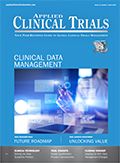The Practice and Promise of Data Science in Clinical Trials
Jennifer Bradford, head of data science for Phastar, shares data and analytics-related learnings from a diverse career journey in research
Applied Clinical Trials spoke recently with Jennifer Bradford, PhD, head of data science for the global CRO Phastar, where she discussed data and analytics-related learnings from a diverse career journey in research-and how she sees the value of data science evolving and contributing to clinical development practice in the future.
Q: Your career path has gone from academia, to industry, to charity/non-for-profit organization, and now at a CRO. What are your generalized takeaways or learning from those different organizations?
Jennifer Bradford: The academic environment was a wonderful opportunity to be on the leading edge of research, however the activity was often very focused on a single project.
Jennifer Bradford

Moving into industry and now a CRO, I have a much greater breadth to the projects and data science techniques and have the opportunity to work with a wider range of individuals while still being on the cutting edge. Also, in industry, data science is more widely recognized and thus provides different challenges and different stakeholders.
While it was a valuable experience working with charity and the NHS, I was involved with what some viewed as “disruptive technologies,” which evoked a culture of fear of the unknown or “rocking the boat.” This was a challenging environment to work in as new technologies are really paving the way for better outcomes.
Today, as head of data science for Phastar, I’m having the opportunity to help clients better understand the value of data science. The challenges are different but they are exciting and enjoyable, particularly now that I have the expertise to provide a solid balance between industry and research.
Q: At AstraZeneca, you worked alongside medical scientists, statisticians and software developers to maximize the value from clinical trial data across therapy areas through data analytics, machine learning (ML), text mining, and data visualization approaches.Can you share examples of what value you were able to derive from these data-based approaches?
JB: Three major areas stand out: accessibility of data, insights generation through the right analytics, and decisions supported by data and evidence vs. feelings and intuition.
For accessibility of data, interactive visualization enables the scientific teams to answer questions in the moment, rather than assembling a list of questions to be answered later.
Improved collaboration leads to faster and more accurate decision-making. The right visualization is key to enabling people to understand and interpret results efficiently and put them into use.
Insights generation through the right analytics, for example AI techniques, can be used to support earlier decision-making by utilizing text mining or ML on historical data to support findings on a clinical trial and/or make decisions on trial design.
And, as mentioned, decisions supported by data and evidence are much more accurate and efficient that those based merely on feelings and intuition.
Q: What is most fascinating about data analytics, machine learning, text mining, and data visualization approaches? What is the most misunderstood aspect of these technologies?
JB: One of the most fascinating aspects for me when applying data science approaches is how many clients experience a “light bulb” moment. This happens as they interpret results of an analysis/visualization and spot data in the output that suddenly make sense to them that were not observed before. This can generate real energy around findings and trigger other ideas of what new and pertinent information might be gleaned from the

data.
While not necessarily misunderstood, data science is a relatively new application in healthcare/trials given the advancements in computing power and data availability. Although mathematical approaches are generally well-known, I think that awareness and understanding of what is possible through the application of data science is not fully understood, including the fact that it’s not “one size fits all.” Data science is about the entire strategy-from question to data source, analysis, and presentation of results-not just a specific analytical approach.
Q: As a CRO, Phastar works on complicated clinical studies. How will your specific focus on data science help operationalize its efforts for clients?
JB: For one, centralized risk-based monitoring (RBM) helps streamline trials while alleviating labor-intensive and costly SDVs (source data verifications). At the same time, it improves data quality by guiding and prioritizing-site visits and setting and monitoring quality tolerance limits using statistical methods. All this adds up to the good clinical practice mission of strict oversight and improved and more efficient approaches to clinical trial design, conduct, oversight, recording, and reporting while ensuring participant safety and clinical study data accuracy and completeness.
Additionally, data science complements the existing statistics and programming expertise at Phastar and works

within the same high-quality framework. Innovative approaches and new technologies are helping to provide more comprehensive and real-world information in the conduct of clinical trials.
This means that data science teams supporting trials must be highly skilled and adept at delivering high-quality advice and results, not only for standard clinical trials, observational data and studies, but also to help businesses understand what is possible in this new frontier.
Q: As you just started with Phastar, what aspects around data sources, as a CRO, do you find most important? And most challenging?
JB: What we do find most important, as well as challenging, is a general understanding of what data sources are available. For example, data sources can vary, such as clinical data, real-word data, wearables data, free-text data, and more. So, we need to be aware of these and other sources and how to access them. We also need to understand different standards and be able to work with different types of data. We need to be able to handle big data sources. I recently saw the term “deep data,” which refers to having access not only to data, but data that is high quality and actionable.
Q: Where do you see clinical research in five years in regard to the use of data science?
JB: If you consider the pace of new data science technologies and the value they bring to healthcare/clinical trials, it seems likely that data science will become an integral part of clinical research, enabling teams to make informed decisions based on evidence. As we have so many possible sources of data to support data science, I see these as becoming more integrated and accessible to support research.
I also believe that clinical teams will continue to maximize the value of the data they have available to support data-driven decisions and to provide efficiencies throughout the trial process.

Including Women of Childbearing Age in Clinical Research
March 26th 2024In recognition of International Women's Month, we're featuring this recent talk between Associate Editor Miranda Schmalfuhs and Marie Teil, Global Head of UCB’s Women of Childbearing Age Program. They speak about the specific challenges women with chronic illnesses face when accessing appropriate treatment and participating in clinical trials, UCB's Women of Childbearing Age Program and it’s most successful strategies, and much more.
Improving Engagement While Maintaining Data Integrity & Validity
March 19th 2024In recognition of Women's Health Month, we're featuring this recent talk between Associate Editor Miranda Schmalfuhs and uMotif's Chief Product Officer, Julia Lakeland, discuss new technologies improving patient engagement and reducing the emotional and logistical burdens of participation, ethical considerations that should be addressed when implementing those technologies, while ensuring patient privacy, and much more.